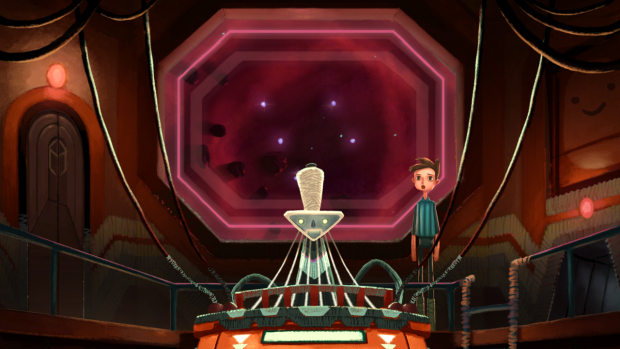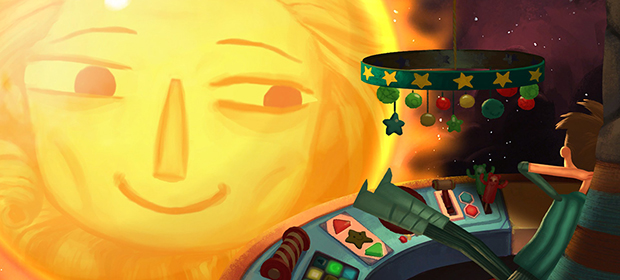In every slither of news, every preview and in each impending review for Broken Age, the sixteen-year absence of Tim Schafer from the point and click adventure game will be mentioned. Once a heavyweight of the genre, having worked on such wildly successful titles as Monkey Island II, Day of the Tentacle and Full Throttle, Schafer bowed out from both Lucasarts and adventure gaming with his magnum opus, Grim Fandango. Since that time the game has become universally recognised as not only the high water mark for the genre but also the Albatross around its neck, with its big-budget, low-return performance marking the end of a golden age.
So what chance did Broken Age stand when it finally saw its release. It was already burdened with over-whelming expectation. The first title from a returning past master, the biggest Kickstarter campaign in the history of the site – this game was set to be the greatest graphic adventure ever made, right? That kind of expectation was dangerous for a game that so many people had already invested their money in based on the pedigree alone. With that level of excitement around the project, it is therefore not entirely surprising that the end result isn’t as earth-shattering as some might have hoped.

That isn’t to say the game isn’t good, it is just a little under-whelming. The story concerns two young people, both coming of age and growing into the world they live in, looking for a purpose. You can choose to play either story from the start, and switch between the two whenever you wish. First there is Vella – a young girl from the city of Sugar Bunting (once known as Iron Bunting, home of fearsome warriors, it is now the home of excellent bakers). Once every fourteen years the monstrous Mog Chothra comes to claim a sacrifice from every city, or else leave it in ruins. It is a great honour to be chosen as the sacrifice, so when Vella is selected her family are so proud – but the spirited Vella isn’t about to let her young life be ended by a silly tradition.
In the other half of the story, we encounter Shay. He has lived his whole life aboard a spaceship, alone but for the ship’s computer who acts as an over-bearing Mother figure. All he has ever wanted is a bit of excitement and a break from the hum-drum, cotton wool-wrapped life that the computer confines him to. When Shay finally finds a like-minded soul onboard, his whole life is turned upside-down, and a host of new challenges and dangers lay before him. Both stories are perfect metaphors for the teenager in all of us, struggling to break free from our family and carve our own way through life, no matter how scary that may be.
The premises are both intriguing and will keep you wanting to learn more about both characters and their situations. There are twists along the way, and the two stories intertwine, but unfortunately because of the ability to switch between Shay and Vella whenever you please, the narrative control is lost somewhat and many of these surprising moments or the lines hinting at twists in the story are a little lost. True, it is nice to be able to switch at leisure, but the net result is less directorial control over the way the game plays out. The dialogue is very well-written and is both sad and funny in places, but perhaps most interestingly it is far more serious than previous Double Fine offerings, which will perhaps surprise many fans.
The other shock is that, coming from a designer who has worked on so many revolutionary and critically-acclaimed adventure games, the puzzle design throughout the game is actually incredibly simple. The puzzle design isn’t bad, as it all remains fairly logical (which can often be an issue in graphic adventures), and they all integrate well into the story and setting. The issue is that the puzzles are all pretty simple, to the point where you will never be truly stumped at a single one. There is no hint system at all, but none is needed as all puzzles are either simple straight off the bat, or you are given such a plethora of hints during conversations and through examining items, that you won’t need to resort to asking for help.
This leads to the first act feeling pretty short and a little unsatisfying. The game is only likely to last three to four hours for most gamers, and there’s little sense of satisfaction when you progress. The puzzles all hold the same level of challenge, meaning that the gameplay never manages to reach a crescendo – despite the story obviously building up to a mid-game cliff-hanger at the end of Act 1.
What will strike you as soon as you launch the game is the wonderful visual style. Broken Age literally looks like a painting come to life, with beautifully drawn backgrounds and character sprites, animated in a wonderfully smooth way. The characters drift through the series of fantastic locations, each more visually exciting than the last – even those set in usually-bland spaceship corridors. Both of the protagonists, as well as the other people you meet on your journeys, are full of character and even with a fairly simple style, they effectively portray emotion throughout the game. This firmly two-dimensional style certainly places design over technology, and is a welcome throwback to graphic adventures of the past.

The sound design in Broken Age is also immediately stunning. Both the musical score and the voice acting are top-notch, but again more under-played than that found in previous Double Fine titles. Even the ever-energetic Jack Black (albeit in a minor role) manages to tone down his usual brash style to fit with the overall mood of the game – which is more contemplative than action-packed. The two leads also do well to bring their respective characters to life as likeable and relatable protagonists.
VERDICT: Broken Age does a fine job of creating an outlandish world populated by interesting characters, but is let-down somewhat by its core gameplay. The style and story are both very strong and will draw you into the game; sadly however, adventure games are generally concerned with puzzle solving, and the puzzles found in Broken Age just don’t test your little grey cells as much as one would like. They are logical and integrated into the game very well, but there is very little challenge to them. Hopefully, this is down to the game looking to get progressively harder as it goes on and Act 2 will be more challenging. As it is, Act 1 feels a little light.

GOOD. A game that scores 7/10 is worthy of note, but unworthy of fanfare. It does many things well, but only a few of them incredibly well and, despite a handful of good qualities, fresh ideas and solid mechanics, it fails to overwhelm.
Review code provided by publisher.







